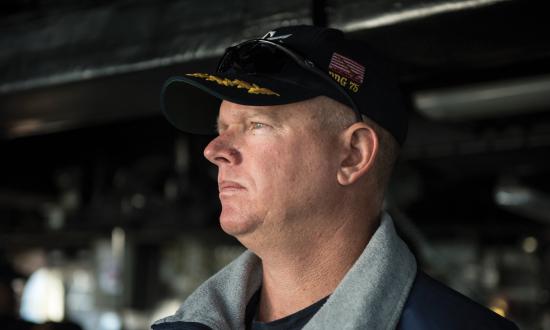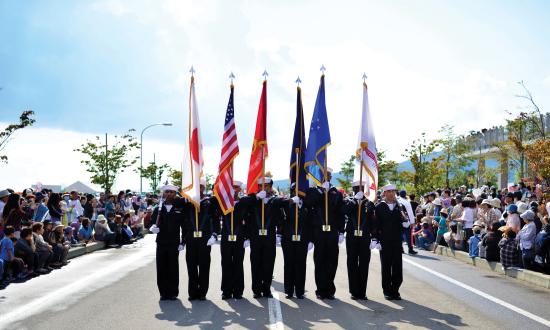Over the past few years, I have had a number of long discussions with friends who did not make it to the end of their command tours. None of them committed treason or sexual assault, ran their ships aground, or suffered collisions or allisions. Their unfortunate mistakes did no lasting damage to any ship or person (except maybe themselves). They did not break any laws or Navy regulations (outside of the “catch-all” Article 134). But their mistakes cost them the most precious thing a naval officer can have: their superiors’ “confidence in their ability to command.” To be fair, I had my share of close calls during my command tours. But this is not about who gets away with what; it is about the way we treat those who took the challenge, rose to the occasion, and then at some point—before the band played at their outgoing change of command—fell from grace in the eyes of their superiors. As one put it, “We are like broken shower shoes—the Navy can’t decide whether to keep us or throw us out, but our presence is annoying.” It need not be this way.
Those who fail to succeed at the apogee of their careers, in command tours they sacrificed a great deal to achieve, should be treated better by the Navy—especially when, as John Paul Jones said, they made well-intentioned errors and not acts of malice. We must also consider, as a service, if the “zero defect” culture for commanding officers (COs) is what we really want to cultivate. The threat (or the perception of the threat) of being relieved for a single mistake leads to timid leadership at all levels. It is a main ingredient in creating leaders who fear risk and avoid it at all costs; they know a single mistake may sack their careers. Managing risk wins battles; avoiding risk loses them.
Before discussing what should happen to someone who falls short in command, it is worth looking at the career path that brought him or her to command. Through a series of selection boards, mostly consisting of individuals who have successfully completed at least one command tour, the Navy has put its “stamp of approval” on every individual who ascends to command at sea. It should stand to reason, therefore, that each failure should prompt introspection and even some level of investigation into the selection process and the individual’s history for signs of shortcomings that could be used to improve the selection, training, and preparation processes. To my knowledge, nothing like this occurs either in the immediate aftermath of a CO’s dismissal or in the long term. The Navy simply makes a decision to fire a CO and moves on. An investigation is conducted, usually by someone several paygrades senior to the commander, but (except when deaths or massive damage occurs) the results are rarely shared within the Navy, and they certainly are not made public. Thus, on a recurring basis, opportunities are lost to be a learning organization where it matters most.
I am not advocating leniency for commanders guilty of criminal behavior or gross negligence. On the contrary, this is a discussion of non-criminal, well-intended mistakes that lead to relief—and in those cases there should be a process to provide counseling, follow-up, and evaluation beyond the immediate chain of command. Every former CO is a person—with family, friends, shipmates, and colleagues who will be curious about what happened. The following is a set of ideas gathered from my own experiences as a chief of staff and in discussions with a number of former COs who were relieved of command early:
1. First, do no more harm. Unless there are criminal charges, the Navy should eliminate the almost automatic default to a “detachment for cause” and a “show cause” process for non-criminal events that would not or do not result in non-judicial punishment or court-martial for the individual. Once told he or she no longer has upward mobility, a former CO can be removed from command and allowed to separate or retire as soon as possible or begin another tour, now as a non-due-course officer.
2. Standardize the investigation process. When I conducted the USS Porter (DDG-78) 2012 collision investigation, I did so on two days’ notice with no planning or training. I have since attended the National Transportation Safety Board (NTSB) and the Coast Guard Mishap Investigation courses; the Navy should have a cadre of well-trained officers prepared to conduct investigations such as these, given the sensitivity of such situations. There are formal mishap investigation classes led by the Navy Safety Center, the Coast Guard, and the NTSB. Such training should be part of the training pipeline to be a commodore or immediate superior in command (ISIC).
3. Facilitate mental health counseling. Any CO who is relieved for cause will likely suffer from depression and feelings of guilt, shame, loneliness, and grief. One former CO told me he experienced suicidal ideations as a result of his early relief, and although he did not act on those impulses, he had never once felt similar thoughts earlier in his life. He sought help on his own, but not all will do so.
4. Facilitate family counseling. The family is part of the equation. They will have challenges adjusting to the relief from command of their husband, wife, father, or mother. The relief will likely play out in the news, meaning that the officer’s failures become public knowledge and will stay with them forever (the internet never forgets).
5. Provide solid legal counsel. Given the gravity of what a dismissal for cause means for an officer’s livelihood, more should be done to explain the process, the officer’s rights, and possible outcomes. These individuals deserve good counsel with their interests in mind. Some who have been through the process shared that this area was lacking.
6. Revisit the process. The overall process (relief for loss of confidence/detach for cause/show cause for continued service) should be more structured with a defined opportunity and process for appeal, even if the individual has been removed in the short term. A “show cause” board may be triggered as well, and that board’s recommendation is a separate decision that can affect the individual’s retention and retirement options, depending on his or her time in the Navy. There are other avenues to upgrade a servicemember’s post-Navy status in terms of rank and benefits, such as the Board of Corrections to the Naval Record, but these are time-late processes, and no real data exists as to their chances of success.
7. Leverage their experience. There are learning opportunities in mistakes, from an institutional and personal level. Establish a process to capture these lessons—even without direct attribution—and share them. Perhaps knowing what happened to a peer will help someone make a better decision or ask for help later. Many relieved COs built a career serving others; allow them to use their unfortunate circumstance to help others (should they choose to do so). If allowing them to teach and help others gives them closure, why squander that opportunity? In many cases, the perceived threat of the process outlined in (6) above suppresses any inclination to share lessons. As one individual who had been through the process put it, “I find myself having to protect my future and my family from the very organization that I love—when I could have made it better.” Is this the desired outcome?
8. Should they choose to remain on active duty, detail to them to the right position. These individuals could fill billets where their exceptional skills could be put to good use. For example, if a former CO was a superb operational planner he could work as a plans officer at a numbered fleet headquarters. Lack of success in the most challenging position in the Navy does not equate to total failure as a naval officer—or a lack of future value to the organization.
What to do with relieved commanding officers is a tough discussion, but we should not shy away from it. There are also different ways to look at situations where our Navy tends to fire COs. Once during an exercise overseas, a U.S. Navy destroyer and a British frigate “traded some paint” during a small boat transfer. The next day at a gunnery exercise, the British ship was on the gun line, and the U.S. ship was headed to port to embark the investigation team. The British admiral running the exercise was surprised at this decision. “It’s a warship; it’s a bump; it happens. Move on,” he said. One of my British colleagues added that he had experienced a minor collision in command and had received a letter from the First Sea Lord that read, “You became a better naval officer today.”
To revisit the “broken shower shoe” analogy, my wife insists I buy quality shoes, and if they suffer minor damage, I get them repaired and put them back in service. Good leaders do not grow on trees, and no organization ever has enough of them—and the rest are watching.








